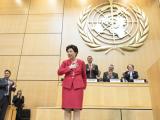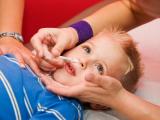Jan 24, 2013 (CIDRAP News) – In a new analysis of serologic studies from 19 countries, researchers estimate that about 24% of the population were infected with the 2009 H1N1 influenza (pH1N1) virus during the first year of the pandemic, a finding modestly higher than what US health officials estimated in the immediate aftermath of the pandemic.
When the estimate is combined with recent estimates of the pandemic's death toll, it appears that about 1 in 5,000 (0.02%) of those infected with the virus died, says the report by a large team of researchers from the World Health Organization (WHO) and many other institutions. It was led by Maria D. Van Kerkhove, PhD, of the WHO and Imperial College London.
In accord with previous findings, the analysis showed that pH1N1 incidence varied widely by age-group, with the highest rates in children and the lowest in people 65 and older, who enjoyed a degree of protection by virtue of exposure to related H1N1 viruses much earlier in life. The study was published Jan 21 in Influenza and Other Respiratory Viruses.
The popular view of the 2009 pandemic is that it was fairly mild, even though it defied the typical seasonal flu age pattern by hitting younger adults more often than the elderly. But the authors note that its global impact is not well understood, largely because with the high volume of cases, the WHO recommended early on that testing focus on severe and fatal illnesses only. As a result, the numbers of cases and deaths reported to the WHO—fewer than 1 million and more than 18,449, respectively—are believed to be small fractions of the true numbers, they write.
They say their study is the first to assess pH1N1 serologic data by age-group from countries and regions around the world.
By searching the literature and contacting researchers, the authors found 27 published and unpublished serologic studies with data available by Jan 1, 2012. They looked for studies that assessed overall and age-stratified antibody titers against pH1N1, as measured by hemagglutination inhibition (HI) and microneutralization (MN) tests. Seropositivity was defined as an HI titer of at least 32 or an MN titer of at least 40.
The research includes serologic data from low-, middle-, and high-income countries, ranging from China, India, Iran, and Vietnam to Australia, France, Norway, and the United States.
To evaluate the cumulative incidence of pH1N1 infection, the team used studies that assessed the difference between pre-pandemic and post-pandemic prevalence of antibodies to the virus. They also estimated the prevalence of pre-existing cross-reactive antibodies to the virus by looking at studies that included serum samples collected before the pandemic, from 2004 to April 2009.
The overall pre-pandemic prevalence of pH1N1 antibodies was just 5% (95% confidence interval [CI], 3%-7%), the authors determined. The number varied considerably by age and was highest in the elderly (65 and older), at 14% (95% CI, 8%-24%).
For cumulative incidence of infection, the authors came up with an overall estimate of 24% (95% CI, 20%-27%). The figure was highest in children (ages 5 through 19), at 46% (95% CI, 36%-56%), and lowest in the elderly, at 11% (95% CI, 5%-18%).
In between were children 0 to 4 years old, 37% (36%-56%); adults 20 through 44, 20% (13%-26%); and those 45 through 64 years, 14% (9%-20%).
These numbers are, overall, moderately higher than estimates the US Centers for Disease Control and Prevention (CDC) made for the impact of the pandemic in the United States from April 2009 to April 2010. The agency estimated that 61 million Americans had been infected, or about 19.8% of the 2010 population of 308.7 million, as compared with 24% in the WHO study. The CDC said the total could have been anywhere from 43 million to 89 million, with 61 million as the midlevel estimate.
In addition, the CDC estimated that 25.7% of children ages 0 through 17 were infected, according to reports at the time. That compares with the WHO estimate of 37% for children through age 4 and 46% for those ages 5 through 19.
Also, the CDC put the adult infection rate at 18.5% for those ages 18 through 64, whereas the current study listed 20% for those 20 through 44 years old and 14% for those 45 through 64. And for the elderly, the CDC estimated a 15.8% infection rate, versus the global estimate of 11%.
The WHO researchers say their age-specific cumulative incidence findings were consistent across countries, which might have been strengthened because they carefully categorized their sera according to the timing of collection relative to the pandemic peak in each country.
If the findings in the 19 included countries are similar to the rest of the world—for which few data exist—and if recent pH1N1 mortality estimates from two research groups are confirmed by other studies, pH1N1 case-fatality rate would be less than .02%, the report says.
It cites in particular a study published last September in Lancet Infectious Diseases, in which a large international group of scientists estimated that the pandemic virus caused 201,200 respiratory-disease deaths and 83,300 cardiovascular deaths from April 2009 to August 2010.
In discussing possible limitations of the study, the authors said they found conflicting results when they assessed the potential impact of pH1N1 vaccination on their findings. Because of this, and because vaccine coverage in most countries was low when samples were collected, they believe the vaccine had little impact on their results.
"Our data demonstrates that approximately 24% of the populations of countries for which there are data were infected during the first wave of the pandemic, with incidence reaching 50% in school-age children," the authors conclude. They say their findings also point up the need to standardize seroepidemiologic studies and include them in pandemic preparedness plans.
Van Kerkhove MD, Hirve S, Koukounari A, et al. Estimating age-specific cumulative incidence for the 2009 influenza pandemic: a meta-analysis of A(H1N1)pdm09 serological studies from 19 countries. Influenza Other Respi Viruses 2013 (early online publication Jan 21) [Abstract]
See also:
April 20, 2010, CIDRAP News story about CDC estimate of H1N1 cases
Sep 2012 Lancet Infectious Diseases report
CDC estimates of pH1N1 cases, hospitalizations, and deaths from April 2009 to April 2010
Information on WHO initiative to estimate pH1N1 mortality
Mar 23, 2010, CIDRAP News story "Study: In life-years lost, H1N1 impact had sizable impact"


















